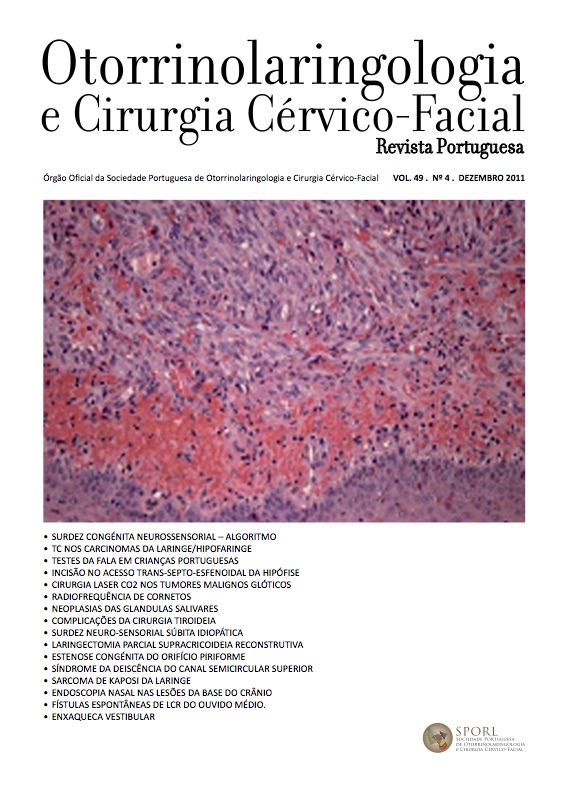Radiofrequency of turbinates. Our experience
DOI:
https://doi.org/10.34631/sporl.194Keywords:
radiofrequency, turbinate hypertrophy, rhinomanometryAbstract
Introduction: Inferior turbinate hypertrophy represents one of
the most frequent causes for nasal airway obstruction. Turbinate
radiofrequency is a relatively new technique presenting several
advantages when compared with other alternatives.
Objectives: To evaluate the efficacy and complications of
radiofrequency in patients diagnosed of inferior turbinate
hypertrophy.
Methods: We present a retrospective study of 40 patients with ages between 14 and 60 years old, with nasal airway obstruction due to inferior turbinate hypertrophy refractory to medical therapy.
Patients were treated with radiofrequency under local anesthesia.
We analyzed the nasal flow with active anterior rhinomanometry
previous and post treatment (at 3 and 6 months). We compared the subjective and objective improvement in all patients analyzing as well the rate of minor and major complications.
Results: Our rate of complications is low, and we had no data of
major complications, having found only a 5% of minor complications as (crust formation or tissue necrosis). The rhinomanometry is a technique that allows us to observe the objective improvement or not, that patients manifest in a subjective way. We obtained an 80% improvement in nasal airway flow at 3 months having this value decreased in 10% at the 6 months follow up.
Conclusion: The radiofrequency of the inferior turbinate is an effective technique that presents some advantages when compared with other methods: does not need nasal packing, does not alter the mucosa and consequently preserves the mucociliary transportation. Presents a low rate of complications and it’s a simple procedure.
Downloads
References
Atef A, Mosleh M, El Bosraty H, Abd El Fatah G, Fathi A. Bipolar radiofrequency volumetric tissue reduction of inferior turbinate: does the number of treatment sessions influence the final outcome? Am Rhinol. 2006 Jan-Feb; 20(1):25-31
Liu CM, Tan CD, Lee FP, Lin KN, Huang HM. Microdesbrider-assisted versus radiofrequency-assisted inferior turbinoplasty. Laryngoscope, 2009 Feb; 119 (2): 414-8
Hytönen ML, Bäck LJ, Malmivaara AV, Roine RP. Radiofrequency termal ablation for patients with nasal symptoms: a systematic review of effectiveness and complications.
J. Basterra Alegría, M. Armengot Carceller. Piramide nasal, fosas nasals y senos paranasales: bases embriológicas, anatomía y fisiología aplicada. Tratado de Otorrinolaringología y Patología Cervicofacial, 2009 Elsevier España, S.L.
J. S. Lacroix, B.N. Landis. Fisiología de la mucosa respiratoria rinosinusal y trastornos funcionales Enciclopedia Medico Cirurgica, Elsevier Masson, 2010. 20-290-A-10.
Cavaliere M, Mottola G, Iemma M. Comparison of the effectiveness and safety of radiofrequency turbinoplasty and traditional surgical technique in treatment of inferior turbinate hypertrophy.
Otolaryngol. Head Neck Surg. 2005 Dec; 133(6): 972-8 Eur Arch Otorhinolaryngol. 2009 Aug; 266(8): 12257-66. Epub 2009 Feb 3. Review.
Yilmaz M, Kemaloglu YK, Baysal E, Tutar H. Radiofrequency for inferior turbinate hypertrophy: could its long-term effect be predicted with a preopertative topical vasoconstrictor drop test? Am Rhinol. 2006 Jan-Feb; 20(1):32-5
Bhandarkar ND, Smith TL. Outcomes of surgery for inferior turbinate hypertrophy. Curr Opin Otolaryngol Head Neck Surg. 2010 Feb; 18 (1): 59-53
Harril WC, Pillsbury HC 3rd, McGuirt WF, Stewart MG. Radiofrequency turbinate reduction: a NOSE evaluation
Laryngoscope. 2007 Nov; 117 (11):1912-9
Salzano FA, Mora R, Dellepiane M, Zannis I, Salzano G, Moran E, Salami A. Radiofrequency, high-frequency, and electrocautery treatments vs partial inferior turbinotomy: microscopic and macroscopic effects on nasal mucosa. Arch Otolaryngol Head and Neck Surg. 2009 Aug; 135 (8): 752-8
Cavaliere M, Mottola G, Iemma M. Monopolar and bipolar radiofrequency thermal ablation of inferior turbinates: 20month follow-up. Otolaryngol. Head Neck Surg. 2007 Aug; 137(2): 256-63
Farmer SE, Eccles R. Understanding submucosal electrosurgery for treatment of nasal turbinate enlargement. J. Laryngol Otol. 2007 Jul; 121 (7): 615-22. Epub 2006 Nov 28. Review
Nease CJ, Krempl GA. Radiofrequency treatment of turbinate hypertrophy: a randomized, blinded, placebo-controlled clinical trial. Otolaryngol Head and Neck Surg. 2004 Mar; 130 (3): 291-9
Kezirian EJ, Powell NB, Riley RW, Hester JE. Incidence of complications in radiofrequency treatment of the upper airway.
Jacquelynne Corey, John Pallanch. Evaluation of nasal breathing function with objective airway testing.
Cummings Otolaryngology, Head and Neck Surgery 5th edition
Seren E. Effect of radiofrequency volumetric tissue reduction of inferior turbinate on expiratory nasal sound frequency. Am J Rhinol Allergy. 2009 May-Jun; 23(3):316-20
Roth M, Kennedy DW. The case for inferior turbinate preservation. Rhinology a state of art. 1994 Kluger publications: 109-112.
Janda P, Sroka R, Betz CS, Baumgartner R, Leunig A. Laser treatment for hyperplastic inferior nasal turbinates: a review. Lasers Surg. Med 2001;285(5):129-39
Porter MW, Hales NW, Nease CJ, Krempl GA. Long-term results of inferior turbinate hypertrophy with radiofrequency treatment: a new standard of care? Laryngoscope, 2006 Apr. 116(4): 554-7






